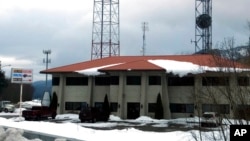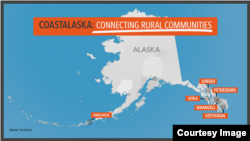In the remote and rural communities of southeastern Alaska, news is never in short supply thanks to a small but dedicated crew of journalists.
“We are what we call community radio,” said Angela Denning. The radio journalist is the regional news director of the media nonprofit CoastAlaska and oversees six newsrooms.
All of them, she said, are “pretty darn remote.”
Just one person runs the newsroom in Wrangell — an island borough of little more than 2,000 people on the Alaska panhandle — while two people run the newsroom that Denning oversees in Petersburg, another panhandle town.
“It has 3,300 people. It's on an island, so no roads in or out. We take planes, we take boats,” she told VOA.
Denning says their audiences rely on stations like hers for news and natural disaster warnings. But radio also provides a human connection that is harder to achieve through websites.
“It’s very personal,” said Denning, adding that listeners often tune in for updates on middle school basketball games, or just to hear the voices of their neighbors, friends or colleagues.
That personal connection serves them well as CoastAlaska teams up with media nonprofits working to prevent the spread of disinformation.
Communities where agriculture, logging or mining are the main industries are seeing a growth in misinformation and disinformation, media groups say. To stem that, organizations like the Rural News Network and the News Literacy Project work with affiliates, including CoastAlaska, to offer audiences the tools to spot and debunk false information.
Local media are often on the front line of fighting disinformation, said Mike Webb, the News Literacy Project’s senior vice president of communications.
As the U.S. prepares for elections, his nonpartisan group is helping newsrooms like Denning’s to equip audiences with the tools they need to spot misinformation.
Ten years ago in Alaska, Denning said, misinformation and distrust in media were less of a worry.
“Trust. It was something we took for granted,” she said. But now, “we don't assume there’s trust anymore. Quite the opposite.”
To build and preserve trust, CoastAlaska works with its community to help audiences feel more involved. They have changed the formats of public forums to allow more engagement and to receive feedback from their audiences.
For instance, when residents felt as if they didn’t have a voice in a local election, the journalists set up a way for audiences to ask questions at a borough assembly candidates forum.
For the first half, the media asked questions. Then they let residents quiz the candidates.
“We pulled their names out of the hat during the program so that those people would be able to ask the questions,” Denning said. And people had to ask their question to all the candidates, not just one.
It was one way for some people who are suspicious of or don't have much trust in media outlets to feel like they were empowered and part of the process.
“I think it kind of worked,” she said. “We got good feedback about it. But of course, we approached it very carefully.”
Part of CoastAlaska’s success is its existing connections with the audience.
“I think it works because we are covering community-based local events such as who's going to tell the community how the high school did at their basketball game over the weekend. That's us,” Denning said.
In her region, the most engagement their reporting receives is often on the successes of students or community member profiles, Denning said. Though, she added, the reporters also cover issues like landslides, conflicts with the logging industry, and economic problems.
"Our listeners and readers may not agree with everything we say but they also really appreciate the coverage that we give to the community, all those little things,” she said.
Despite being largely isolated on islands in the state’s southeast, Denning’s reporters are always talking with each other.
“If you're in constant contact with your colleagues, even if they're a few hundred miles away on a different island, you can still feel supported,” Denning said. “During this time of misinformation and distrust, that's more important than ever.”















